The Best 'Dracula' Film Ever Made
An analysis of why ‘Bram Stoker’s Dracula’ is the best cinematic portrayal of Dracula.

He’s the king of vampires. He’s been in movies, books, comics, and theatre. Hell, there’s a puppet on Sesame Street and a cereal mascot modeled after him. Let me tell you something: Count Chocula is pretty goddamn delicious. I used to eat it while watching Dracula movies. Huh. Just typing that gave me some insight into myself. Anywho, Dracula is probably the most adapted literary character in any medium. If he’s not being adapted outright, there are characters that invoke him. Whenever vampire stories are created, he’s always on the artist’s mind, whether they are influenced by him or not. In fact, Dracula has become such a staple, some people think Dracula is the first fictional vampire ever created. That distinction goes to a guy named Varney. Varney the Vampire. No. I’m not making that up.
No character has ever appeared in movies more than Dracula. He’s been around since cinema was in its infancy. In fact, Dracula has been in cinema for 100 years since Nosferatu first premiered in 1922. German filmmaker, F.W. Murnau tried to pull a fast one and adapt the novel by Bram Stoker and changed the names of the characters, took a few liberties with the source material, and dropped the movie in theaters like no one was supposed to notice. Bram Stoker’s estate noticed of course and sued. The court ruled that all copies of the film be destroyed. There were some prints that survived, thankfully, and the film has been nightmare fuel for one hundred years. My advice: Don’t watch that movie at two o’clock in the morning. Just don’t do it. Trust me. Dracula in this film is renamed Count Orlok and he’s not the sexy man in a satin cape we all love. He looks like a giant rat man. There’s no humanity whatsoever. The film is one of the first modern horror movies and if you feel like being creeped out, it is definitely worth the watch. Mainly because it feels like the actor playing Count Orlok doesn’t seem like he’s acting. It helped invent some of the rules of horror filmmaking.

Two years later, there was a very popular Broadway starring a handsome Hungarian actor. This play was the beginning of Dracula’s rebrand and is responsible for the image we have of him today. Dracula has gotten a makeover. He’s a young man who wears a cape. He’s suave. He also talks like a being that’s trying to pass off as a human being; a creature that has been dead a long time. This was adapted into a feature film by Universal Studios in 1931, kicking off the first major horror franchise. Filmmakers did not know how to use sound in films yet so whenever there are scenes with no dialogue, there are periods of eerie silence that make the viewers uncomfortable. Scenes with Dracula and his brides roaming around the castle are unnerving because Dracula stares at the camera and there isn’t any sound playing. The film is adapted from a stage play and it shows. A good amount of the scares comes from characters sitting around and talking about horrifying things rather than showing them. Characters point to something offscreen and say things like “Wow. Look at that ferocious wolf running away.” It’s still a good movie. Give it a watch. Bela Lugosi’s Dracula is iconic. It’s even what Halloween costumes are modeled off of.
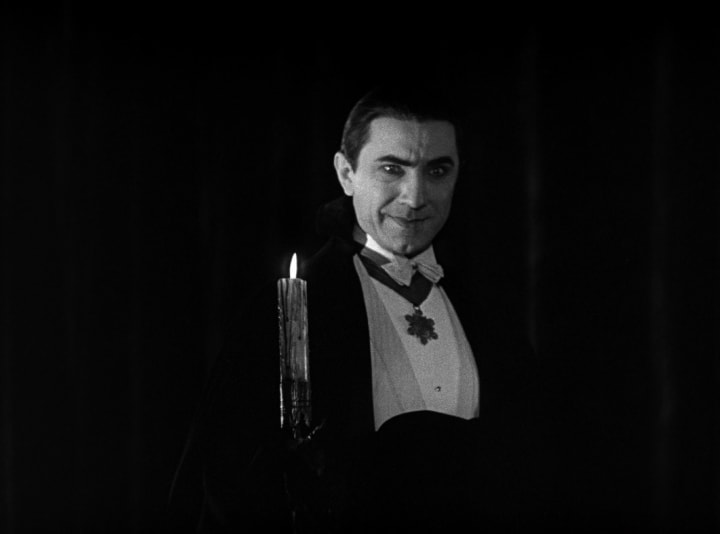
In 1958, Dracula was updated once again. Hammer Horror Productions took the sex appeal of Dracula and brought it front and center. Dracula was played by Christopher Lee who brilliantly balanced portraying a suave gentleman and a predator. Women in the film had cleavage and Christopher Lee’s Dracula is a lot hornier than Draculas that came before. The film is the first time Dracula was shot in technicolor. And he looks beautiful. This kicked off another horror franchise. The other ones are fun but Dracula definitely becomes more of a Freddy Krueger than the king of vampires.

There are all great movies. But, interestingly enough, they are not faithful adaptations of Bram Stoker’s novel. They get some of the aspects right these adaptations cut characters or condensed them. They cut the story and rearranged scenes. But they never adapted the structure of the novel either. That is until Bram Stoker’s Dracula was released in 1992. The film was written by James V. Hart and directed by Francis Ford Coppola. The guy who directed the greatest movie ever made. Together they created the ultimate Dracula film. A film full of idiosyncrasies, oddities, sex, horror, romance, and dare I say, beauty.

I BID YOU WELCOME
Dracula is an epistolary novel. This means that the plot is not presented traditionally with a first-person or omniscient narrator telling us the event of the story. It means that the novel is told through journal entries, telegrams, letters, and newspaper articles. In 1897, this would be the equivalent of a found footage movie. Only it’s about Dracula, not the Blair Witch, or whatever the hell is happening in those Paranormal Activity movies. In these entries we get insights into the character’s psychology and how they figure out what the audience knows: They’re being hunted by a vampire. No other film uses this device except Bram Stoker’s Dracula. The film features the characters’ journal entries presented through voiceover and we connect with the human character more than we had been able to in previous adaptations. Dracula is such a popular character that the audience kinda roots for him to kill people, which should not be happening. Now that we have the entries in the film, we can have characters we care for.
Here is the biggest thing about the novel: Dracula isn’t in it that much. He’s in the beginning and that’s it. No other characters have any memorable interactions except for Jonathan Harker, the most famous and most faithfully adapted portion of the novel. The book never shows Dracula’s perspective due to the narrative device. Although, it would be funny if Dracula’s diary entries were in there. “Dear, Diary. My wives are getting on my ass about food again. Guess I gotta go food shopping. What’s still open? I know. I’ll snatch a baby. That’ll hold them over tonight.”
Since the book never shows Dracula’s perspective, he’s not a fleshed-out character. He’s a monster. People get glimpses of him as he stalks them or when they dream of a mysterious creature entering their rooms at night. This device works in the novel. Since we don’t really know anything about him other than he’s a count that's lived for hundreds of years, we’re left draw our own conclusions about him. And through that, we project our own fears and horrors onto him, which is exactly what our characters do. The book is about ordinary people who are bound together through fighting an evil they do not understand; a heart-warming story about how fear and trauma can lead to strangers becoming a surrogate family struggling to survive.


THE BLOOD IS THE LIFE
Francis Ford Coppola had just finished making The Godfather Part III, a critically divisive film despite being a box-office success. Winona Ryder was originally cast as Michael Corleone’s daughter, Mary. She dropped out at the last minute due to exhaustion. Before she left the production, she handed Coppola James V. Hart’s script. She asked him to read it when he had the chance. She didn’t expect him to but his eyes lit up when he saw the title, Dracula. Coppola had fond memories of the book. He used to read the book at camp when he was a counselor.
Ryder was attracted to the script because it was an emotional love story; something that’s not really associated with Dracula. Ryder saw her character, Mina Murray as a woman with repressed sexuality due to gender norms of the time period. Her friend, Lucy, however, was free. In the story, she’s being courted by three men who want to marry her. She loves her freedom but she has to marry one of them because that is what’s expected of her as a woman in society. But till she makes that decision, she’s gonna have her fun. It’s not until she decides to marry one of them that Dracula shows up, seduces her, assaults her, and turns her into a vampire. Coppola also agreed with Ryder’s take on the script. He used these themes to enforce his directorial decisions, saying he wanted the film to resemble an erotic dream.
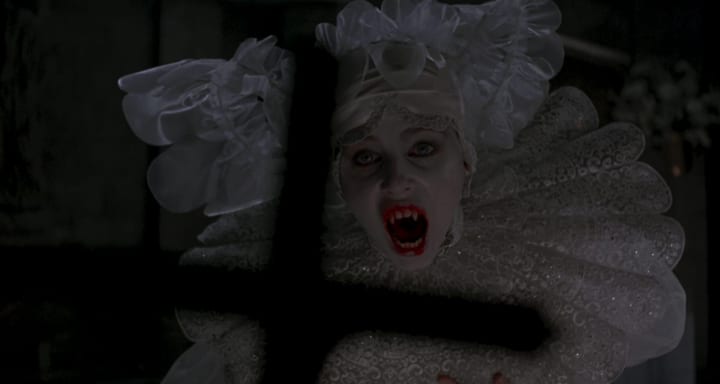
And boy does he succeed. The movie really does feel like a dream. The film was shot on soundstages giving it an artifice that works to the film’s benefit. There was this new thing called CGI at the time but Coppola decided he didn’t want to use it. All the effects would be done in-camera using illusions like forced perspective, models, and projections. Take that along with lavish production design and costumes designed by Eiko Ishioka. The costumes are particularly the highlight. Dracula doesn’t have the slicked-back hair and cape. He’s a very pale old man with translucent skin and the wildest hairdo in movie history.
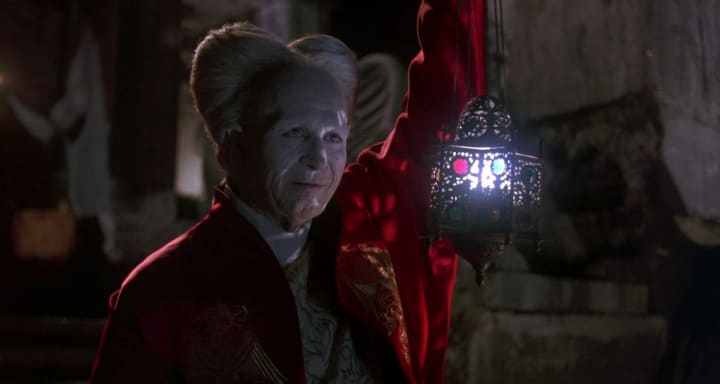
Coppola told his production and costume designers one thing: Be weird. And everyone let their fucking freak flag fly, using Gustav Klimt, Jean Cocteau’s very surreal Beauty and the Beast, and the cinematography of Mario Bava’s films like Black Sunday, Black Sabbath, and Blood and Black Lace.
Coppola paid homage to previous Dracula films. You’ll see visual cues to Nosferatu. Gary Oldman’s accent is modeled after Bela Lugosi’s, even though it’s like three octaves lower. The eroticism of the Hammer films is dialed up to 11. And like those three films, this movie creepy. Really creepy. The vampires’ movements defy the laws of physics and their lack of empathy is disturbing. Take all these ingredients and you have a film that’s one of the most visually unique films you’ll ever seen featuring painterly images that show horrific acts but are beautiful to look at.



OCEANS OF TIME
In addition to being a new interpretation of Dracula. The film is a thesis on Dracula; in dialogue with the previous films and deliberately taking pop culture’s previous notions of him and tossing them out the window. This starts with Hart’s screenplay. When he wrote the film, there were countless Dracula films. How could the film be different from its predecessors? He used the novel’s narrative devices. He made Dracula a horrific monster rather than the charming, handsome guy that never drinks wine. But the story aims to explore something Dracula films rarely did. have tried to do. Was Dracula always a monster? If he wasn’t, then how did he become that way? Hart looked to Stoker’s inspiration for Dracula, Vlad the Impaler. Vlad the Impaler was a warlord in what is now Romania. He was a crazy guy who liked to invade countries, commit genocide, and impale his enemies. He also liked to boil people alive and according to legend, impaled two priests to help them get into heaven. His birth name was also Vlad Dracul or Vlad Dracula.

In the novel, Van Helsing theorizes that Dracula is Vlad Dracul but the novel never confirms. Hart’s screenplay makes the connection explicit, writing a prologue that functions as Dracula’s origin story. The film begins with Vlad the Impaler leaving his wife, Elisabeta, behind to go to war in the name of Christianity. He’s really successful because, you know, he’s really good at killing people and turning them into shish kebobs. The enemy sends false word that Vlad has been killed in battle and Elisabeta commits suicide. The priest tells Vlad that Elisabeta’s soul is damned. He says “fuck you” to God and vows to come back from his death with the powers of darkness. It’s very Faustian and operatic. When we catch up to the present, Vlad has been a blood-sucking ghoul for centuries.
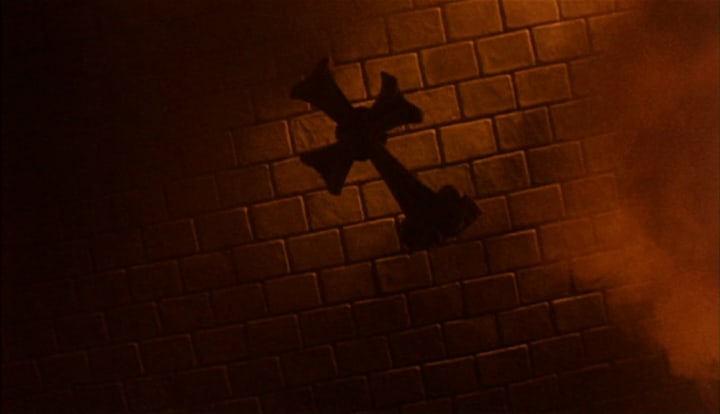
When Jonathan Harker visits Dracula’s castle, Dracula notices a picture of Harker’s fiancee, Mina. Mina is the reincarnation of Vlad’s wife, Elisabeta. This is not a plot line from the novel but it does something that previous versions have never done: Give Dracula urgency. When he sees the picture of Mina, Jonathan Harker is imprisoned in the castle while Dracula heads to London to see Mina. While there, he starts wreaking all sorts of fucking Havoc, but his fixation on Mina now has the proper motivation. He drinks a shit ton of blood (some from her best friend, Lucy, who eventually becomes a vampire herself) to appear younger, something from the novel absent from previous adaptations, and courts Mina as a young prince from a far away. Mina begins to fall in love with Prince Vlad. And why wouldn’t she? He can literally turn her tears into fucking diamonds.

But when Jonathan escapes Dracula’s castle, she leaves London to marry him. And Dracula goes apeshit, murders Lucy, and turns her into a vampire. Mina, Jonathan, Van Helsing, and Lucy’s suitors become a team of vampire hunters and hunt down Dracula. In the film’s climax, she murders him. It’s not treated as an act of vanquishing a monster but setting a man free from damnation.
This makes Dracula a tragic figure. When Dracula sees the picture of Mina, whatever is left of Vlad is peaking through. It’s his shot at redemption. But he is too far gone. He’s committed far too many monstrosities. There is only one natural ending to this story. He’s still a monster; one who commits some of the most horrific acts ever seen in a movie but we can sympathize with him because we understand suffering the pain of a great loss.

WHAT MUSIC THEY MAKE
The film made $215 million dollars at the box office. This was in 1992 and the movie is a hard R-rated movie. Kids should not watch this film. My mother showed it to me when I was five by the way and I still smother myself in blankets at night in case Dracula tries to end my shit. Some would say that’s not a good parenting move. I say, mind your fucking business. It’s one of the movies that shaped me and caused me to write about it 25 years later and make a vampire film of my own. You should check it out. It’s pretty fire. The movie was an event with some of the biggest actors at the time. Anthony Hopkins, fresh off his Oscar win for playing Hannibal Lecter, stars as Van Helsing. Keanu Reeves plays Jonathan Harker, doing probably the worst British accent in cinematic history. Sorry, Keanu. Love you, papi. Come to think of it, Keanu hasn’t aged much in thirty years. Maybe he’s a vampire?

Winona Ryder plays Mina. And the spooky boy, Drac, is played by the incomparable Gary Oldman. Gary Oldman was cursed in his own way after this movie. He spent the next two decades playing villains. He said he never really cared about playing Dracula. He just wanted to work with Coppola. Also when he got to the part in the script when Dracula says to Mina, “I’ve crossed oceans of time to find you,” he knew that he wanted to be the one to say that on camera. He also nails it by the way. It’s also worth mentioning that this odd, surreal, erotic nightmare is the last Dracula adaptation that made waves in pop culture.
What is our obsession with Dracula? Is it the wish fulfillment of immortality? Is it the human curiosity of wondering who the hell lives in the spooky house at the top of the hill? Is it because he’s a hot guy in a cape? Okay, that’s a pretty damn big reason but it doesn’t compare to the main one. We look at a monster and we can’t relate to them. What they do is too horrific for us to process and we all ask two questions whether we’re conscious of it or not: What made them lose their way and become…this? The second question is when I meet tragedy, will I retain my humanity or become a monster myself?
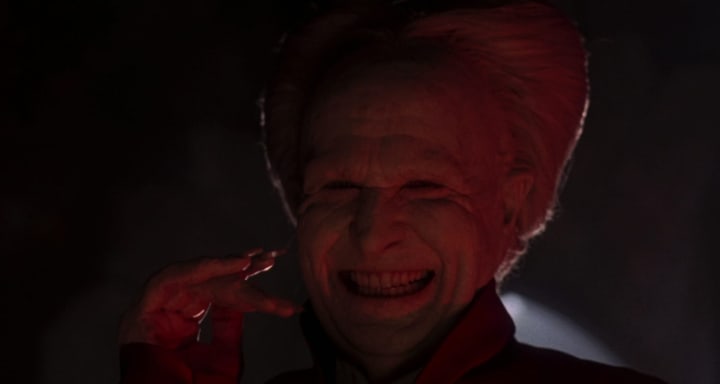
This article first appeared in The Cinemonograph Collection.
About the Creator
George A. Velez
When I'm not directing and writing movies, I write ABOUT them. I talk about them. Sometimes I eat them.
I like movies is what I'm trying to say.
Website: georgeavelez.com






Comments
There are no comments for this story
Be the first to respond and start the conversation.